How To Increase Computer Speed Windows 8
Any yous think of Windows eight (at MakeUseOf, our opinions are mixed), it'south certainly speedy. Windows 8 boots faster than previous versions of Windows, has lower retentiveness usage, and has a desktop that feels overnice and snappy. Similar all versions of Windows, Windows 8 has a variety of settings you can tweak to speed things up and make information technology even faster. Y'all can learn a whole lot about tweaking the Os in our Windows 8 guide.
Some of the tips hither also employ to previous versions of Windows, but Windows viii has some new tricks up its sleeve. As always, there are trade-offs when using some of the below tricks – there's no magic "Go Faster" push button.
Disable Time-Wasting Animations
Windows 8 (and Windows 7) display animations when you minimize, maximize, open, or close application windows. The animations are slick eye-candy, but they do introduce a filibuster. Y'all can disable the animations and window transitions will happen instantly, eliminating the delay.
To disable the animations, printing the Windows central, type SystemPerformanceProperties, and printing Enter. Uncheck the Breathing windows when minimizing and maximizing option. You may also want to disable some of the other animations, such as the Fade or slide menus into view and Fade or slide ToolTips into view. This will make menus and tooltips snap to attention instead of fading in with an blitheness.
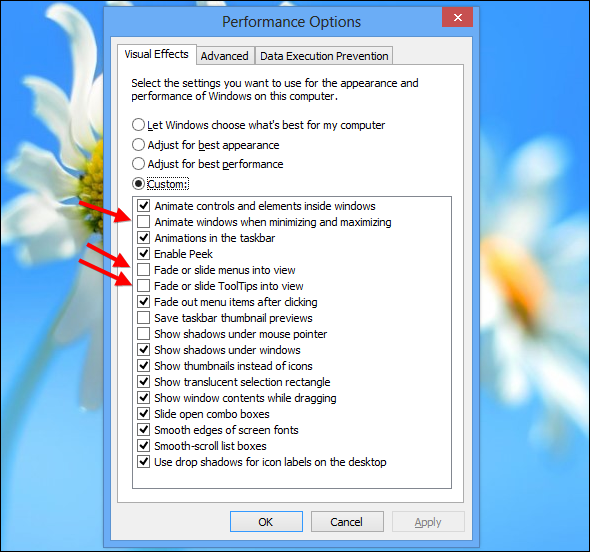
Pinpoint Apps Using Lots of Resources
Windows eight's new chore director allows you to easily pinpoint the programs slowing downward your figurer. To open the Task Managing director, right-click the desktop taskbar and select Task Managing director. Click the More details option if you don't see the full interface.
Applications using a lot of resource will be highlighted, making it easy to see which programs are using up your computer's resources. This list also shows a simplified list of applications, which is easier to understand and skim than the sometime-style processes listing (if you prefer the erstwhile-mode process list, it's nonetheless available on the Details tab).
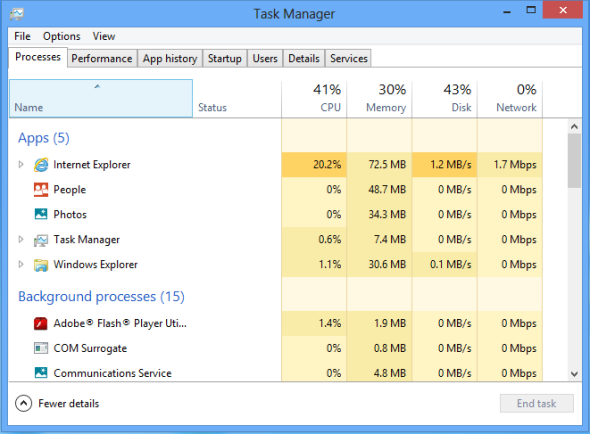
Manage Your Startup Programs
The Windows Job Manager now allows you to easily disable programs that start with your computer. Click the Startup tab in the Task Manager to access these options.
Windows also analyzes how long each program takes to offset and displays this information in the Startup bear upon column. Select a program and click Disable to prevent it from starting with Windows, speeding up your startup process.
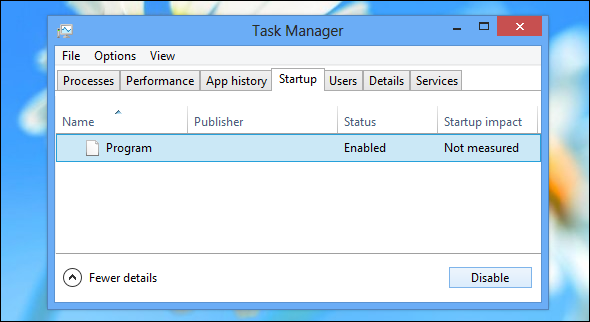
Employ Included Security Programs
Instead of installing third-party security suites that frequently slow down your computer, endeavor using the included security applications. Windows now includes an antivirus – while it'south named Windows Defender, it'south basically the same as the pop Microsoft Security Essentials application.
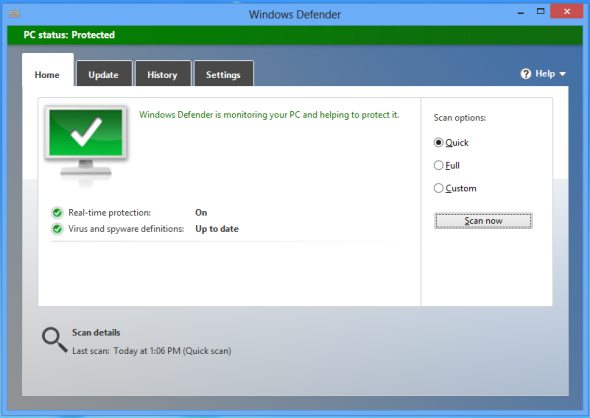
Windows 8 likewise includes a SmartScreen feature, which analyzes how trustworthy programs you download are. As in previous versions of Windows, Windows also includes a firewall that blocks incoming connections. If yous want more settings and options, you may want to install a third-party security suite – but most users will detect that Windows 8's included security programs are finally complete enough to rely on.
Alter Power Settings
Windows 8 uses ability plans to determine whether bombardment life or performance should be prioritized, just every bit previous versions of Windows do. To view your ability plan settings, press the Windows key, type Power Plan, click Settings, and press Enter.
In the default Balanced mode, Windows automatically reduces your CPU's speed when maximize speed isn't needed. This saves power. To squeeze all the performance you can out of your hardware, you lot may desire to endeavour High performance instead. In High performance way, your CPU's speed is never reduced. It runs at full speed all the time.
However, this isn't necessarily a good thing. Even loftier-performance gaming PCs are used for spider web browsing some of the time and information technology doesn't make sense to run the CPU at full throttle while browsing the spider web. This just wastes power and generates additional oestrus.
Whichever plan you choose, brand certain you aren't using Power saver. This is only useful if you desire to clasp every bit much battery life out of your laptop as possible.

Put Your Reckoner to Sleep
One of Windows 8'south nearly controversial aspects is the way it buries the Shut Downwards option in a hidden menu. Microsoft wants to encourage you lot to use Sleep way instead of shutting downward your computer. When you apply Sleep, your estimator goes into a very low-power state that uses just enough ability to go along your programs and open files active in your computer'due south RAM. When you come up back to your computer, it will resume from sleep almost immediately. Using Sleep instead of Shut Downwards can dramatically speed things upwardly when y'all sit downwards at your figurer.
You'll find a Sleep option nether the power push button in the Settings charm. (Press Windows Central+C, click Settings, click Power, and select Slumber). Your estimator's power push button may also be configured to utilise Sleep automatically. Y'all can change this pick by clicking the Choose what the power buttons do selection in the Power Options window mentioned higher up.
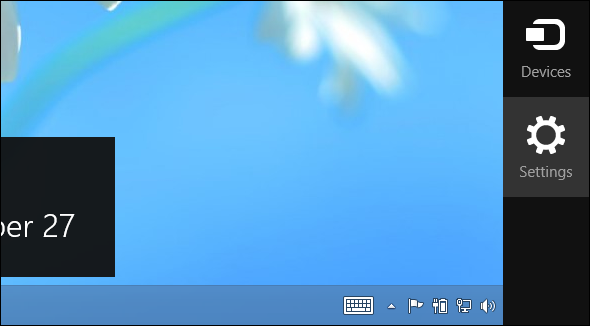
Optimize Your Hard Drives
Windows 8 includes the standard Disk Defragmenter, at present named the Optimize Drives tool. To access information technology, press the Windows primal, type Defragment, click Settings, and press Enter. Note that Windows 8 automatically optimizes (defragments) your bulldoze once per calendar week by default. However, if yous move a lot of files around, you may want to optimize your drives sooner.
As on previous versions of Windows, click the Analyze button to see exactly how fragmented your file systems are.
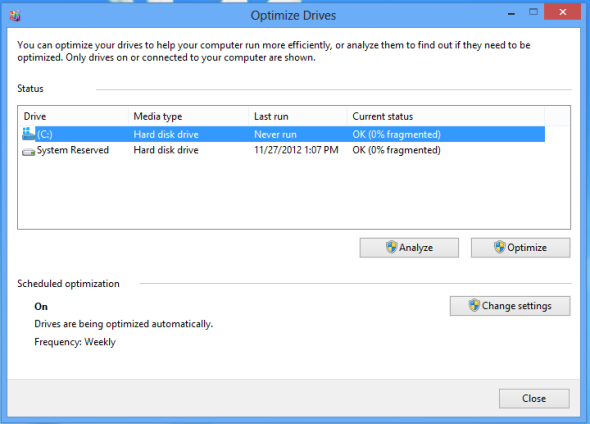
Command Windows Indexing
The Windows indexing service automatically scans the files on your computer and monitors them for changes, allowing you lot to quickly search for files without waiting. Indexing uses some CPU time (and uses more CPU time if you frequently alter a lot of files) so disabling information technology can assistance you reduce CPU usage.
Acquit in listen that indexing speeds upwardly searches. If you lot regularly use the Files search feature on the Start screen or the search feature within Windows Explorer, you won't want to disable indexing. You should merely disable indexing if yous don't employ the search feature.
To disable Windows Search, press Start, type services.msc, and printing Enter. Scroll downwards in the list, locate the Windows Search service, right-click it and select Properties.
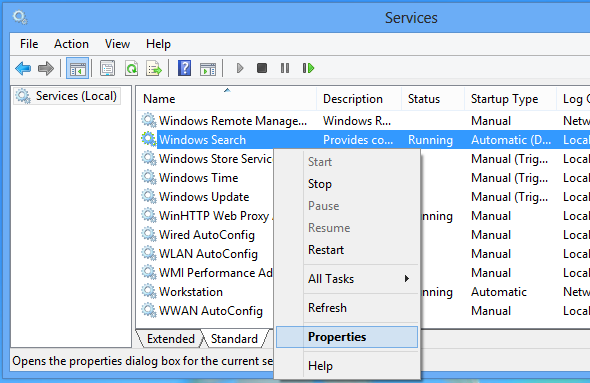
Gear up the Startup type box to Disabled, click the End push to stop the service, and click OK.
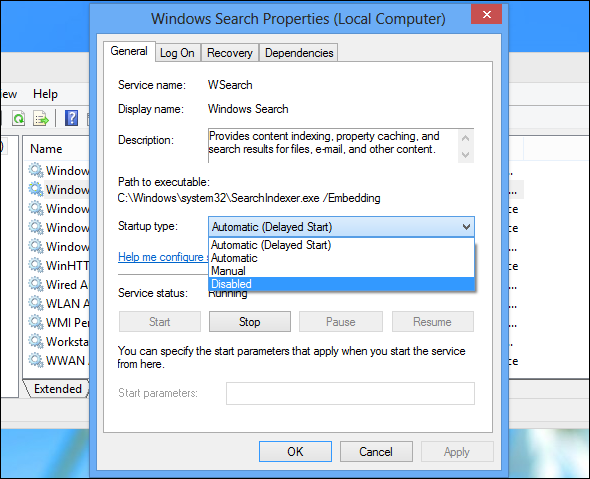
Instead of disabling the indexing service entirely, you may besides want to command which folders Windows Search indexes. By default, it indexes your Users folders. if you have some folders full of files you lot don't want to search, peculiarly ones that frequently change, you may want to exclude these folders from being indexed. To control these settings, printing the Windows primal, type Indexing, click Settings, and press Enter.
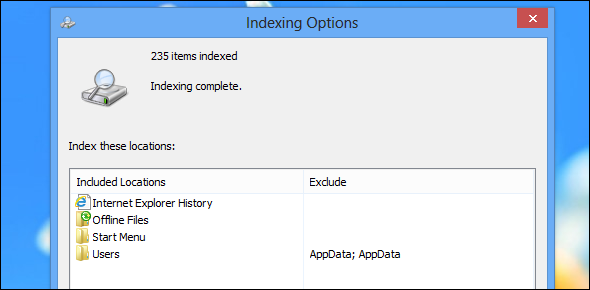
For more than information near Windows 8, be sure to download our gratis guide to Windows eight.
Practise y'all have any other tips for improving Windows eight's performance? Leave a comment and share them!
Source: https://www.makeuseof.com/tag/how-to-make-windows-8-faster/
Posted by: barronciame1947.blogspot.com

0 Response to "How To Increase Computer Speed Windows 8"
Post a Comment